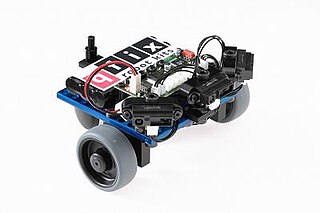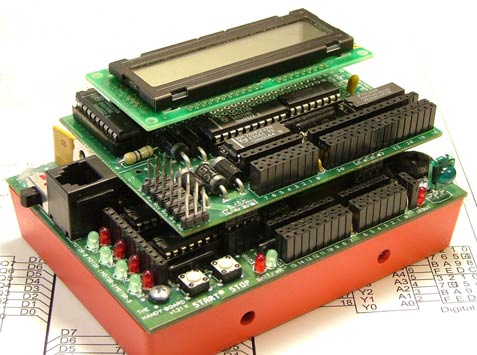
The 68HC11 is an 8-bit microcontroller (µC) family introduced by Motorola in 1985. Now produced by NXP Semiconductors, it descended from the Motorola 6800 microprocessor by way of the 6809. It is a CISC microcontroller. The 68HC11 devices are more powerful and more expensive than the 68HC08 microcontrollers, and are used in automotive applications, barcode readers, hotel card key writers, amateur robotics, and various other embedded systems. The MC68HC11A8 was the first MCU to include CMOS EEPROM.

An embedded system is a controller programmed and controlled by a real-time operating system (RTOS) with a dedicated function within a larger mechanical or electrical system, often with real-time computing constraints. It is embedded as part of a complete device often including hardware and mechanical parts. Embedded systems control many devices in common use today. Ninety-eight percent of all microprocessors manufactured are used in embedded systems.

AVR is a family of microcontrollers developed since 1996 by Atmel, acquired by Microchip Technology in 2016. These are modified Harvard architecture 8-bit RISC single-chip microcontrollers. AVR was one of the first microcontroller families to use on-chip flash memory for program storage, as opposed to one-time programmable ROM, EPROM, or EEPROM used by other microcontrollers at the time.

The MSP430 is a mixed-signal microcontroller family from Texas Instruments. Built around a 16-bit CPU, the MSP430 is designed for low cost and, specifically, low power consumption embedded applications.

The BASIC Stamp is a microcontroller with a small, specialized BASIC interpreter (PBASIC) built into ROM. It is made by Parallax, Inc. and has been popular with electronics hobbyists since the early 1990s.
A phidget is a physical representation or implementation of a GUI widget. For example, an on-screen dial widget could be implemented physically as a knob.
A general-purpose input/output (GPIO) is an uncommitted digital signal pin on an integrated circuit or electronic circuit board whose behavior—including whether it acts as input or output—is controllable by the user at run time.
The Gigabeat was a line of digital media players by Toshiba.

qfix robot kits are an education tool for teaching robotics. They are used in schools, high schools and mechatronics training in companies. However, the robot kits are also used by hobby robot builders. The qfix kits are often found in the RoboCup Junior competition where soccer robots are built of the kit's components.
Interactive C is a program which uses a modified version of ANSI C with several libraries and features that allow hobbyists to program small robotics platforms.

The Pepper Pad is a Linux-based mobile computer with Internet capability and doubles as a handheld game console. It also serves as a portable multimedia device. The device uses Bluetooth and Wi-Fi technologies for Internet connection.
The MIDIbox project is an open source modular DIY framework, consisting of hardware and software, MIDI platform built around the PIC family of microcontrollers — the PIC18F452, PIC16F88, PIC18F4620 and PIC18F4685 and, more recently, the STM32FXX and LPC1769 32-bit. It can be used to build hardware MIDI control units for various synthesizers, multi-track recording software, and other MIDI devices; as well as stand-alone synthesizers, sequencers and other projects.
This is a list of Nintendo GameCube accessories.

A single-board microcontroller is a microcontroller built onto a single printed circuit board. This board provides all of the circuitry necessary for a useful control task: a microprocessor, I/O circuits, a clock generator, RAM, stored program memory and any necessary support ICs. The intention is that the board is immediately useful to an application developer, without requiring them to spend time and effort to develop controller hardware.

Servos are small, cheap, mass-produced servomotors or other actuators used for radio control and small-scale robotics.
The following outline is provided as an overview of and topical guide to electronics:

NuttX is a real-time operating system (RTOS) with an emphasis on standards compliance and small footprint. Scalable from 8-bit to 32-bit microcontroller environments, the primary governing standards in NuttX are POSIX and ANSI standards. Additional standard APIs from Unix and other common RTOSes are adopted for functionality not available under these standards, or for functionality that is not appropriate for deeply embedded environments – such as fork.
UDOO is a single-board computer with an integrated Arduino Due compatible microcontroller, designed for computer science education, the world of Makers and the Internet of Things.

The Arduino UNO is an open-source microcontroller board based on the Microchip ATmega328P microcontroller and developed by Arduino.cc. The board is equipped with sets of digital and analog input/output (I/O) pins that may be interfaced to various expansion boards (shields) and other circuits. The board has 14 Digital pins, 6 Analog pins, and programmable with the Arduino IDE via a type B USB cable. It can be powered by a USB cable or by an external 9 volt battery, though it accepts voltages between 7 and 20 volts. It is also similar to the Arduino Nano and Leonardo. The hardware reference design is distributed under a Creative Commons Attribution Share-Alike 2.5 license and is available on the Arduino website. Layout and production files for some versions of the hardware are also available. "Uno" means one in Italian and was chosen to mark the release of Arduino Software (IDE) 1.0. The Uno board and version 1.0 of Arduino Software (IDE) were the reference versions of Arduino, now evolved to newer releases. The Uno board is the first in a series of USB Arduino boards, and the reference model for the Arduino platform. The ATmega328 on the Arduino Uno comes preprogrammed with a bootloader that allows uploading new code to it without the use of an external hardware programmer. It communicates using the original STK500 protocol. The Uno also differs from all preceding boards in that it does not use the FTDI USB-to-serial driver chip. Instead, it uses the Atmega16U2 programmed as a USB-to-serial converter.













